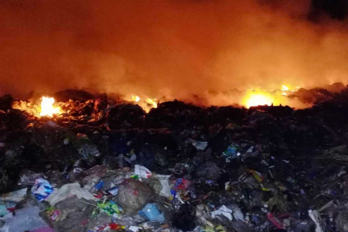Municipal waste dumpsites are a fire hazard and the most effective way to minimize the risk of fire is to manage the LFG.
MSW dumpsites are a fire hazards
Unmanaged municipal solid waste dumpsite are an eye-sore, but they don't pose a concrete hazard for the general population. That's the reason why so many dumpsites are left unmanaged for decades
Despites some of the more or less perceivable hazards such as: plastic and paper scattering for 100s of meters: social and economic impact such as land depreciation; and bugs and repelling odors; there is a more sinister hidden hazard: LFG
When municipal solid waste (MSW) is first deposited in a landfill, it undergoes an aerobic (with oxygen) decomposition stage when little LFG is generated. Then, typically within less than 1 year, anaerobic conditions are established and methane-producing bacteria begin to decompose the waste and generate LFG in larger quantity.
LFG (Land Fill Gas) is a natural by-product of the decomposition of organic material in anaerobic (without oxygen) conditions. LFG contains roughly 50 to 60 percent methane and 40 to 50 percent carbon dioxide, with less than 1 percent non-methane organic compounds (NMOCs) and trace amounts of inorganic compounds.
Landfills are among the largest anthropogenic methane sources worldwide, ranking third after agriculture (livestock farming and rice cultivation) and losses from fossil fuel distribution, processing and mining.
Methane account for about half of the total LFG. Methane is a potent greenhouse gas (more than 25 times stronger than carbon dioxide over a 100-year period) and has a short atmospheric life (~12 years). Methane is odorless and colorless making it almost impossible to detect without proper instruments, and this, together with its high flammability, poses a high safety risk where the LFG is not properly managed.
Fires occurring at landfill sites are an ongoing, complex problem that has existed for decades. Landfill fires threaten the environment through toxic pollutants emitted into the air, water, and soil. These fires also pose a risk to firefighters and civilians who are exposed to the hazardous chemical compounds they emit. The degree of risk depends in part on the contents buried in the landfill, the geography of the landfill, and the nature of the fire. There can be great difficulty in the detection and extinguishment of landfill fires, which is compounded because these fires often smolder for weeks under the surface of the landfill before being discovered.
The good news
Fire prevention actions can reduce property damage and the risk of injury and death, as well as decrease health and environmental hazards associated with landfill fires. As a rule, the cost of prevention is less expensive than the cost of fighting and cleaning up a fire. The principal methods for landfill fire prevention are effective landfill management and appropriate methane gas detection and collection.
Because methane is both potent and short-lived, reducing methane emissions from MSW landfills is one of the best ways to lessen the human impact on global climate change. In addition, all landfills generate methane, so there are many opportunities to reduce methane emissions by flaring or collecting LFG for energy generation.
With a heating value of about 500 British thermal units (Btu) per standard cubic foot, LFG is a good source of useful energy, normally through the operation of engines or turbines.
In conclusion
Landfill management is a vital key to efficient landfill fire prevention, however it is a complex and challenging task requiring cooperation among various stakeholders such as waste generators, regulators operators and communities.
Landfill gas management can however provide an array of benefits to all stakeholders including:
- fire prevention by eliminating the chance of hot-spots;
- leachate management by adding controlled relief paths; and
- environment protection by collecting the methane.
The only sustainable approach to environmental, lifes and livelihood protection is to adopt and implement a sound framework and not to fall complacent about the risks associated with the disposal of municipal solid waste.
